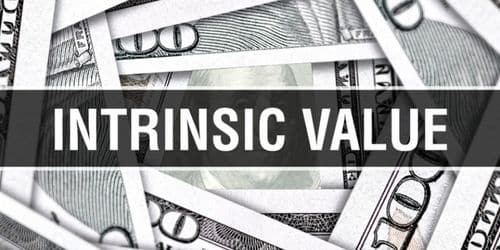Learning how to find the intrinsic value of either a stock or a firm may be quite difficult. This often occurs when an individual does not have a proper understanding of what it is.
The application of the right steps and formula will help in simplifying the process of finding an intrinsic value. In order for you to know how to find the intrinsic value, you will need to have a proper understanding of what it’s all about.
What is the Meaning of Intrinsic Value?
An asset’s intrinsic value can simply be defined as the measurement of its value and actual worth. Many times, especially during a negotiation, determining the value may be difficult. However, it is essentially what an individual is willing to pay for an asset. Getting the value or trying to determine the actual worth of an asset is a complex procedure. This is simply because of their infinite life, including the difficulty of estimating cash flows in the future.
There are many investors who frequently make use of more than one approach, in order to determine the estimated value or actual worth of an asset. Notwithstanding, there are three main approaches to determining the value of an asset. They include;
- Relative Valuation
- Discounted Valuation
- Asset-based Valuation
Examples of Intrinsic Value
There are various examples of intrinsic value. This is because an intrinsic value simply means worth, whether it’s an individual /object or the calculated value of an asset. For example, when it comes to humans, some examples of intrinsic values are beauty, courage, integrity, temperance and many more.
On the other hand, in business, one of the examples of an intrinsic is when a person calculates the total worth of a business by breaking it down, with the use of a formula, therefore arriving at an actual worth. That is also an example of intrinsic value. The same thing goes for determining the value or actual worth of a person’s assets.
Meaning of Intrinsic Value in a Stock Market
In order for you to understand the true meaning of intrinsic value in a stock market, you will first need to know how to value a stock. The return on a stock in a stock investment comprises two things, mainly cash dividends and capital gains or losses. These are the two main components of your return on investment.
Therefore, an intrinsic value in a stock market can simply be defined as the anticipated worth of the actual value of the stock.
Understanding the Intrinsic Value of a Stock
When you purchase a stock, you’re paying in cash the stock price that is quoted on the stock market. In return, you will get a proportional ownership that each stock represents in the company. This piece of ownership represents the proportional claim of all the cash that can be taken out of the business during its remaining life.
This includes the company’s existing cash, which is the cash that is already generated. The cash that we’re talking about is the free cash leftover, after paying for all the operating expenses. You simply pay price in exchange for value.
If the value of all the cash that you’re getting is higher than the stock price that you’re paying then that’s a really good investment. In other words, you are paying a price that is below its intrinsic value and also profiting from the difference.
Where to Find the Intrinsic Value Stock
Since there is no particular method for determining the intrinsic value, you can easily find the value of a stock, firm, or asset by using highly recommended formulas. These highly recommended formulas are usually from people like Ben Graham, Warren Buffett, etc.
Nonetheless, there are various apps that have been designed for the purpose of calculating the actual worth and value of a business. These apps are created to make calculations less, which makes them easier and faster. One of these apps is called CoValue.
This app has various features. The CoValue has been designed to create valuations of companies, which is usually based on the Discounted Cash Flow, popularly known as DCF. This process helps to determine the intrinsic value of an asset, business, or company faster.
How Do You Find the Intrinsic Value?
By learning how to accurately calculate the value and actual worth of a stock, firm company, or anything in general, you’ve automatically got the fundamental tool of investors.
Are you purchasing an item or an asset for less than it’s worth? Are you overpaying for the cash flows of a business? If you can answer these questions, then you should know exactly what sort of return you’re going to make from a stock.
Being aware of the kind of risks you are taking is also essential. One thing a lot of investors and business owners don’t know is that calculating the actual value has to do with a part of art and also a part of science. The goal of calculating an actual value is to be approximately right, rather than wrong.
You also need to have it in mind that every business, regardless of its size or how well it’s doing, has a worth.
According to John Burr Williams in his 1938 publication, “The Theory of Investment Value”, value is determined by the cash inflows and inflows, discounted at an appropriate interest rate, that can be expected to occur during the remaining life of the business.
In addition, when it comes to calculating the actual value of a company or stock, this can be done in several ways unlike that of assets like houses, cars, etc. There are several ways of calculating an intrinsic value, one of them is called the DCF method.
THE DCF METHOD
The DFC method simply means discounted cash flow. The value of a dollar will not be the same in ten years due to inflation. However, by applying the DCF method (discounted cash flow), you are automatically calculating the cash flows of a company for the next few years. This will need you to find out the equivalent value in the current worth of money.
In order to get an analysis using the DCF method (discounted cash flow) for a company, that company must have a positive free cash flow. The free cash flow is used to understand the movement of money. In other words, it is the cash left over, after all the expenses of a company has been paid. The number of this cash is usually found in their cash flow statement.
Step-by-step guide for calculating intrinsic value using the DCF method
- Calculate and get the estimated company’s cash flows of the future.
- After the company’s future cash flows have been estimated, then you’ll calculate the current value of each of the cash flows.
- Finally, in order for you to get the intrinsic value, you will need to get the sum total of the current values.
Therefore, DCF = CF1/(1+r)¹ + CF2/(1+r)² + …+ TV/(1+r)n.
CF simply means the cash flow expected for a particular period. For example, CFI = cash flow for one year.
r simply means the discount rate.
TV stands for the terminal value.
n simply stands for a specific period of time. For example, days, weeks, months, years or even quarters.
What is the Intrinsic Value Formula?
An intrinsic value can be defined as the process of calculating the value or actual worth of an asset. As mentioned earlier, there are several ways to determine the actual value of an asset. This is usually because the criteria of businesses vary.
Below is a common formula which is used by several investors.
INV = EPS (earnings per share) × ( 1 + r) × P/E ratio.
Furthermore, another way is to get the estimated company’s future cash flows, then calculate the current worth of each future cash flow. Therefore, the intrinsic value will be equal to the sum total of the current values.
Market Value vs Intrinsic Value
The market price of a stock is the outcome of the desires of both the buyers and sellers to either unload or get the shares. Market value can fluctuate a lot over time and it is highly influenced by the rise and fall of production and also the output of the company.
Market Value
Many a time, there can be a large change in the stock prices which usually follows the release of quarterly earnings for a company. Investors usually buy it and sell off stock in response. The intrinsic value is seen as the true value and this is used to compare against market value in determining if a stock is overpriced or undervalued.
Intrinsic Value
The intrinsic value is only as good as the information used to determine it. Many sources can come up with different intrinsic values, based on the company’s criteria and information that they can assess. For example, a member of the company may have access to more reliable information than an outside investor. This will make the members of the company knowledgeable therefore having a more accurate calculation of its intrinsic value.
By reviewing past value cash flow and the risks associated with the company, an investor can use this information to determine an intrinsic value. There are several calculations that can be used to determine the actual value of an asset or business. One of the most common is the discounted cash flow model. This relies on cash flow in the cost of capital for the weighted average cost of capital. Which type of capital is rated by the percentage of total capital and summed together.
One of the main reasons why the actual value is so important is, with the right information about a company and investor can calculate their worth to compare against the market value. In the process of making the decision to buy or sell stock, the investor is able to label the stock is undervalued or overvalued.
Comparing Intrinsic and Market Value
An overvalued stock has an actual value under the market value. On the other hand an undervalued stock has a higher increasing value than the market value. If a stock’s current value is calculated to be $70 per share, the investors stand to benefit significantly by purchasing stock at $8 per share.
For the more common it also has room for market fluctuations to occur and still be ahead. This only happens as long as the actual value remains higher than the market value. This specific calculation is essential for new investors and for those with limited funds. An investor can maximize their profits and sell prior to the market value there for reaching its calculated value.
What are Intrinsic Factors?
An intrinsic factor can simply be defined as the major characteristics that make up an individual internally. For example, characteristics or factors like genetics, age, etc. Intrinsic factors generally refer to the influence it has internally, (from the inside).
To Wrap It Up
An intrinsic value is all about determining the actual value and worth of a business or an asset. However, apart from businesses and assets, everything else has value, including human beings. The only difference is that the value of humans is not calculated.






